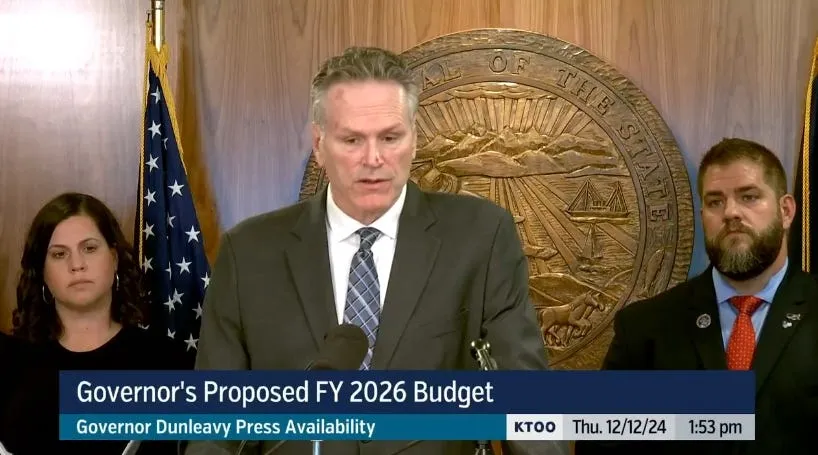Day 17: Senate goes big on school funding/Chief Justice Winfree gives a fitting farewell
"With apologies to Led Zeppelin and ‘Stairway to Heaven,’ and those too young to understand the reference."

Happy Marmot Day, Alaska! It’s Day 17 of the 2023 legislative session.
In this edition: The bipartisan Senate Majority has rolled out its proposed increase to school funding, which would not only help districts keep up with inflation but give them some extra resources. What’s particularly interesting about the move is how senators framed it as part of the hard choices that will need to be made with the dividend. Also, the Alaska Legislature hosted one of the final stops on the “Chief Justice Winfree farewell speaking tour,” hearing soon-to-be-retiring Chief Justice Daniel Winfree’s excellent State of the Judiciary Address that delivered a hopeful message for Alaska’s children (of all ages) and a fierce defense of the judiciary’s independence. Also, the daily schedule.
Current mood: 🙂
Programming note: I’ve got a few questions about the whole shake-up, so I wanted to take a moment to clarify some things. First, the name change on the newsletter is purely cosmetic, nothing will be changing with your subscriptions and you won’t be having to jump through hoops to subscribe to a second newsletter. Second, while The Alaska Current is paying me for my writing, this newsletter has now become my primary source of income, so I still very much appreciate (and depend upon) your support of my work. You can help by subscribing or sharing this newsletter.
$1,000 increase to per student funding ‘is the beginning of the beginning,’ says Senate Majority

The bipartisan Senate Majority rolled out what senators called a “bold” approach to funding schools on Wednesday that not only seeks to make them whole with years of inflation and flat base funding, but would put additional money into Alaska’s schools.
By the numbers, the plan would increase the base student allocation by $1,000 to $6,960. That number is fed through a funding formula that determines just how much state money each district gets depending on the number of students, their needs and the district’s location. In total, it’s estimated that it would cost the state about $257 million, a roughly 20% increase to school funding.
The proposed increase, which is contained in Senate Bill 52, exceeds what schools and advocates have asked in order to “stop the bleeding” as one-time money and pandemic money that helped paper over the widening gulf between the current funding levels and inflation.
“We arrived at this number because we want to take a bold approach, a bold step,” said Anchorage Democratic Sen. Löki Tobin, the chair of the Senate Education Committee, during the Senate Majority’s weekly news conference. “We heard from many of our stakeholders in testimony that $860 was the minimum, and we didn’t want to just help stop the bleeding, we wanted to actually put resources into our schools. This is the beginning of the conversation, so we’re going to have more public testimony opportunities and more invited testimony to hear from our education stakeholders about whether this is the right number to land on.”
Tobin and others in Senate leadership explained that the measure is really intended as the opening discussion. The precise number could change and additional sought-after changes like linking the BSA to inflation could be considered.
Paying for it: ‘Do we want to teach our kids to cash checks?’
Of course, with a price tag of $257 million and a deficit in Gov. Mike Dunleavy’s proposed budget that’s likely well north of $300 million there’s a big question about how to pay for everything. That’s where Senate Finance Committee co-Chair Sen. Bert Stedman stepped to talk about the priorities in the budget. Dunleavy’s budget overspends more than $300 million largely because it contains $2.5 billion for full, statutory dividends. That’s more than twice the entire school funding budget.
“If we had a $1,300 dividend, we could pay for the education increase, we could pay for the deficit and we could pay off all the municipal debt for the entire state for municipalities dealing with the Alaska Bond Bank, about $900 million, with this year’s cash flow,” he said. “That’s the magnitude of what we have to give and take when we decide what we’re actually going to fund.”
And later in the news conference, he put an even finer of a point on the issue.
“We’re going to have to make a choice. Do we want to teach our kids to cash checks?” Stedman asked. “Or do we want to teach them to read and write and do arithmetic?”
Why it matters: For much of the interminable battle over the dividend, it’s essentially been framed as the “direct cash checks vs. nebulous government spending.” That’s a hard fight to fight when you can look at “nebulous government spending” and see a whole bunch of things you think you could go without. Framing it as the dividend versus education—and, with Stedman’s suggestion of municipal debt, local property taxes, too—that makes it a clearer battle… an uphill battle, no doubt, but a clearer one.
The Alaska Memo by Matt Buxton is a reader-supported publication. To receive new posts and support my work, consider becoming a free or paid subscriber.
The daily schedule
You can find the full schedule with documents and links to bills on akleg.gov and also get livestreams at Gavel Alaska.
- The House Community and Regional Affairs Committee will continue its hearing on House Bill 22, the pension bill for peace officers and firefighters, at 8 a.m. It’s been one of the spicier series of hearings with Republican Rep. Kevin McCabe doing everything he can to cast doubt on the necessity of giving these public employees a dependable retirement. Bill sponsor Rep. Andy Josephson has proven to be a sharp and forceful advocate for the bill, cutting through the BS.
- Senate Finance Committee meets at 9 a.m. for a hearing on Alaska’s oil tax regime
- House Fisheries meets at 10 a.m. to hear HB 19, dealing with an exemption for boat registrations
- House Energy meets at 10:15 a.m. to get an update from various utility companies
- House Finance Subcommittee on the Department of Commerce meets at 11:30
- House Military and Veterans’ Affairs meets at 1 p.m. to hear a presentation on “key quality of life issues” from the Department of Defense
- House Transportation is hearing from the Department of Transportation at 1 p.m. to get an overview on the state’s aviation facilities
- Senate Community and Regional Affairs is meeting at 1:30 p.m. to get overviews from the departments of Public Safety and Corrections
- House Finance Committee hears the supplemental budget at 1:30 p.m.
- Senate Transportation meets at 1:30 p.m. to get an overview of the ferry system
- House Health and Social Services meets at 3 p.m. to get an overview of the Department of Health
- House State Affairs meets at 3 p.m. to hear HB 3, which would set up gold and silver coins and bars as legal tender in the state of Alaska. It’s by Rep. McCabe. They’ll also be taking public testimony on the bill.
- Senate State Affairs meets at 3:30 p.m. to hear SB 12, an address confidentiality program. They’ll also be taking public testimony.
The ‘Chief Justice Winfree farewell speaking tour’

Chief Justice Daniel Winfree, Alaska’s first Alaska-born Chief Justice, gave his final State of the Judiciary Address to the Alaska Legislature on Wednesday, delivering a hopeful message for Alaska’s children (of all ages) and a fierce defense of the judiciary’s independence. Winfree, who grew up and lives in Fairbanks, is nearing the constitutional age limit for Alaska Supreme Court justices and will be replaced in his role as Chief Justice by Justice Peter Maassen. Judge Jude Pate of Sitka will join the Alaska Supreme Court.
It perhaps the best State of the Judiciary that I’ve heard in my time covering the Alaska Legislature, so I’ll just provide a few key sections of his speech.
On the importance of keeping politics out of the Judiciary:
“I’ve known what the practical definition of an ‘activist judge’ is for years. It’s the judge who rules against you. That’s the activist judge because the losing side is certain, certain that a judge is an activist because the losing side is always, always certain that they couldn’t possibly have been wrong in its interpretation of the facts or the law. It seems like most people base their judgements on our decisions solely on how their internet sources characterize the result, without ever reading or caring about our written explanation of the relevant facts and the law and why we came to our decision. They don’t like the result, we’re corrupt, incompetent or even worse radical liberal activists, radical conservative activists, you name it, that’s what we are. When they like the result, we’re incredibly smart, wonderful or at least a blind pig that can find a truffle.
Unfortunately, this view is easily encouraged and amplified by those who really should know better. Democracy and the rule of law depend on an independent judiciary to make these calls without favor or bias.
I recognize that some here don’t believe in an independent judiciary but rather believe that Alaska’s judges should be hand-picked and controlled by politicians so that the judges will render decisions that the politicians want. Our constitutional convention delegates were aware of that view and they expressly rejected it, along with rejecting the notion of elected judges and they did so in favor of the merit selection process we have in Alaska. The delegates wanted politics out of the judicial selection process all the way up to the governor’s constitutionally authorized appointment of a judge from the list of the most-qualified applicants provided by the Alaska Judicial Council.
With apologies to Led Zeppelin and ‘Stairway to Heaven,’ and those too young to understand the reference, the judiciary was intended to be a rock and not get rolled.”
His closing message, reflecting on his time in service and what it means to have come up from being a kid in Fairabnks.
“You are Alaska’s children. I am one of those children. Just a kid from Fairbanks. Teenage dream of sometime being in a position to make important decisions for the state of Alaska. And 15 years ago, to my delight and surprise, I suddenly found myself one of five people heading a branch of government for the state of Alaska. I have given it everything I have to give, and I have loved every minute of every day.
To all of you other children of Alaska, young and old: Live your lives. Live your dreams. Make Alaska an even better place for everybody.
It’s been an incredible honor to serve. It’s been an incredible honor and a privilege to speak with you last year and this year. And so to all Alaskans, on behalf of the nearly 800 Alaska Court System employees, farewell.”
Watch the full address on YouTube here:
Stay tuned!
The Alaska Memo Newsletter
Join the newsletter to receive the latest updates in your inbox.




